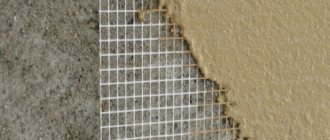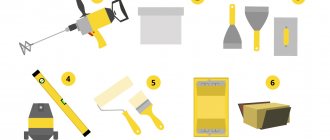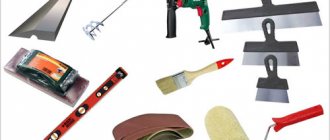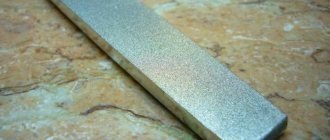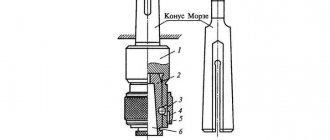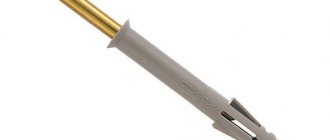Correct Application
Regardless of whether wallpaper, paint or decorative plaster is applied to the walls, at the first stage the surfaces should be leveled and all cracks should be removed.
After this, the walls are plastered and degreased. The next stage is priming the surfaces. When the walls are dry, you can apply the starting putty. During such work, it is necessary to use a spatula correctly. The primer solution is prepared from a dry mixture and water. You should get a homogeneous consistency, for which it is recommended to use a construction mixer. The prepared solution is taken from the container with a small spatula and applied to a wide one. The mixture is applied to the surface at an angle of 45 degrees. As soon as the excess solution on the large instrument begins to dry out, it is removed with a narrow blade. Otherwise, scratches will remain on the walls.
After the putty has dried, the surfaces are primed again and covered with paint, wallpaper or plaster. If decorative plaster is to be applied, then curly tools are used to obtain the desired effect.
Varieties
Tools for puttying surfaces vary in shape and standard sizes, which are necessary for specific work.
Painting spatula
The trapezoidal product has a steel plate 0.5-1 mm thick, which has sufficient rigidity and bends well. The tool has a plastic handle and a minimum blade width of 2 cm. It is intended for the following work:
- marking seams between plasterboard sheets;
- puttying of surfaces and complex structures;
- sealing any cracks and cracks;
- leveling surfaces after applying putty.
Construction stores sell disposable household painting products with a working surface of 0.5 mm. It bends easily, so it is difficult to obtain a smooth surface with its help. Therefore, professionals choose high-quality steel spatulas with a thicker blade.
Tools for facade work
Special spatulas are used for puttying and leveling surfaces that have a large area. They are made of durable steel and have a wide working trapezoidal plate with a width of 30 to 60 cm. Using a rigid, durable and wide blade, the solution is applied immediately to a large area of the surface. For ease of use, the handle is made of two-component plastic rubber.
During finishing work, facade and painting spatulas are used together. It is convenient to apply the solution with façade tools, and to distribute it over the wall or ceiling with painting tools.
Spatula-scraper
To remove excess hardened putty, use a special tool in the form of a scraper. It is distinguished by a rigid, thick blade made of especially durable metal, the width of which can be from five to seven centimeters.
Corner putty tool
To obtain an even internal angle between wall joints and between wall and floor, corner spatulas . The tool consists of two surfaces located at right angles to each other. It is quite difficult to use, which is why such spatulas are used mainly by professional builders.
In addition to those described above, there are types of spatulas that are designed for specific jobs:
- Figured products are used for applying decorative plaster and liquid wallpaper. With their help, they give the walls a certain texture. Curly instruments are made from plastic.
- Rubber spatulas have a working surface from 40 to 80 cm and are used for puttying small surfaces and processing tile joints. Products with a rubber base are convenient for applying sealant.
- Notched trowels are used to apply construction adhesive. The teeth on a tool can be of different widths and shapes. To apply liquid glue, you should choose a product with small triangular teeth. Products with large teeth are ideal for working with gypsum glue. It is recommended to use a notched trowel only on flat surfaces.
Criterias of choice
Construction stores offer a large selection of spatulas, among which you need to choose a convenient and high-quality tool for yourself. To do this, you need to listen to the recommendations of professionals:
- For starting work, products with an iron or steel blade are best suited. To prevent the working surface from rusting, its surface must be coated with a special coating. After use, wipe the blade thoroughly and dry it. This product should be stored in a dry place.
- For finishing work, a blade made of stainless steel is selected. If it is made of a different material, marks may remain on the walls.
- Painting and façade tools must have an elastic blade. It should not be too rigid and at the same time should not bend from the slightest impact on it. It is inconvenient to apply the solution with a hard blade, and the mixture will simply fall off from a soft cloth.
- In construction stores you can see drop-shaped, trapezoidal and triangular products. The most reliable and easy to use blades are in the form of a trapezoid.
- On sale you can see spatulas of various sizes. They can be short or long. Experts recommend choosing medium-sized blades that are most comfortable to work with.
- To apply putty to the walls, use an unsharpened cloth. The sharpened blade is designed for applying adhesive to the tiles.
- The spatula must be carefully inspected. There should be no jagged marks on it, and the blade should be perfectly straight.
Having chosen a tool suitable for the job, you need to hold it in your hands. If holding it is uncomfortable, then you should refuse to purchase it.
Tool characteristics
In appearance, a spatula is a spatula made of different materials, equipped with a handle. It is widely used for repair and construction work. With it you can:
- clean old putty, wallpaper and paint;
- apply cement, putty and other solutions;
- putty any surface;
- lay tiles;
- grout joints in brickwork or tiles.
The blade must be rigid and elastic, meet the requirements of the current state standard 10778−83. The tool has several important and standard sizes. In the first place is the width of the device, which, like other parameters, is selected according to the type of finishing work.
Manufacturers produce professional and non-professional models. Professional tools are distinguished by thick blades, they have a good service life, and they do not deform under load. Non-professional devices have a thinner blade complete with a plastic handle.
Related article: Decorative gypsum panels for walls
For narrowly targeted finishing work, special devices are made.
Levelness control
The main ways to check the quality of a ground surface are touch control and control using developing coatings.
Control using developing coatings
There are two types of developing coatings: dry, which are applied using applicators, and aerosol, in cans.
Before sanding, apply a developer coat to the filled area. As you sand, the development coating will disappear and you will see lower spots where the development coating remains. All you have to do is fill in these “black marks” and repeat the sanding. Remember to thoroughly remove sanding dust before each filler application.
Working with dry developing coating
Control by touch
The most sensitive areas of the palm
Run your palm over the sanded surface and the sensations will tell you where and what defects remain. If the sensations do not change, then the surface is flat; if they change, then there is still something to work on.
There is nothing special to describe here, you will feel everything yourself. In the painting business, trained fingers are highly valued. There is something to train!
Putty station solution
With the mechanized puttying method, both powder compositions and ready-made mixtures are used. Cement and gypsum materials are the most popular among consumers. In addition to the main components, they include plasticizers and special substances that provide additional functions, such as elasticity.
When choosing a gypsum solution, you must take into account that it can only be used for interior decoration of buildings. Its characteristics do not allow the mixture to be used for finishing external facades and wet rooms. The advantage of gypsum is its porosity, due to which it dries quickly.
If it is necessary to carry out exterior finishing, preference is given to cement putty, which has high strength and resistance to moisture. The disadvantages of the composition in this case are poor elasticity, shrinkage and prolonged drying.
Mechanical putty technology
Mechanized putty is carried out according to the following scheme:
- Preliminary surface treatment;
- Preparing a machine intended for puttying walls;
- Mixture supply;
- Leveling the coating.
Each point has its own nuances:
The final result of the activity depends on the quality of the preliminary preparation stage. The main task is to create good adhesion. To achieve the goal, it is necessary to clean the surface of various contaminants and dust. After that, treat the object with an anti-corrosion agent and apply a suitable primer.
The stage of setting up the device includes organizing its delivery to the place of mechanical putty, connecting it to the water supply and heating networks, as well as filling the receiver with material. After the completed manipulations, the master turns on the mixer and starts the equipment, which begins to prepare the mixture for application to the work surface.
Mechanized work on applying the solution is carried out in accordance with the necessary rules.
Sanding the surface can be done either manually or using a grinding machine.
Recommendations for mechanized wall putty are as follows:
The putty gun should be kept at a distance of about 30 cm from the object; The jet should be perpendicular to the wall; You need to start working from the corners, paying special attention to the joints; The width of the putty layer can be adjusted by setting the feed speed of the composition; It must be remembered that the rate of release of the solution affects the delivery range and occurs under high pressure.
Tips for choosing a spatula
Nowadays you can find many stores that sell tools for construction work. But such a large selection gives rise to another problem: how to choose the best quality spatula. After all, there are so many of them on the shelves, they differ in size, shape, materials, and manufacturer. How to choose the right product?
When choosing a spatula for finishing work, you need to pay special attention to the metal from which the tool blade is made
There are some tips:
- The instrument should be immediately taken into your hand; if there is a feeling of awkwardness, then it is not suitable. The blade itself must be perfectly smooth and the end (blade) must not have any jagged edges. Any defect indicates that the product is of poor quality and cannot be used.
- Often there are spatulas that have an uneven surface. It can be short or long. It is better to give preference to the medium size. So, it will be more convenient to work.
- By their shape you can find: trapezoids, triangles, drop-shaped. The best ones are trapezoidal. They are more reliable and easier to use.
- Facade and painting spatulas should not be very hard. It is better to choose a canvas that is elastic, but not bendable from the slightest impact. If the blade does not bend, it will be very inconvenient to apply the mixture to the wall. If it bends strongly, the solution will simply fall off it.
- The tool (its blade) for finishing activities is made exclusively of stainless steel. Other metal will rust and this will cause marks on the walls.
- For starting work, you can choose a product with a steel (iron) blade. It should have a special coating that prevents rust. Such products need good care: after work, wipe and dry, store in a dry place.
- The sharpened blade is not used when applying putty to walls. It is used when applying adhesive to tiles.
There are many products for wall putty. They vary in shape and size. For finishing purposes, facade and painting spatulas are mainly used. They provide the required pace of work and lead to the desired result. Non-professionals should take into account that working with such a tool requires initial skills, but is not as difficult as it might seem. Choosing a device for applying the mixture is not difficult, but you need to be careful. When purchasing cheap products that are made from second-rate material, you cannot be sure that the end result will meet your expectations.
We consider the types and sizes of spatulas for puttying walls
Puttying walls is a common process that covers both rough work and finishing cladding.
To carry out high-quality repair work, spatulas are used, which differ in shape, size and purpose. Today we will look at which spatula to choose for puttingtying walls, how to avoid the appearance of stripes from the spatula when puttingtying walls, and how to work with a spatula correctly when puttingtying walls with your own hands.
Getting to know the tool
Each of us is familiar with the spatula, because its scope of use is not limited to putty. The tool is used to spread and smooth the construction mixture on the surface, remove old paint if you need to remove wallpaper. Spatulas are used when laying tiles and grouting joints between them, laying bricks or cinder blocks; in addition, they are used to identify small defects in walls. The classification of construction tools is carried out not only according to its purpose, but also according to the material of its manufacture. Spatula for puttying walls for professional and non-professional purposes are divided into the following:
- Metal
- Plastic
- Rubber
Important! In order to do the job professionally, you need to use the right spatula. The peculiarity of most tools is that they can be used not for their intended purpose, but for a wide range of actions.
Choosing a staple in a store (video)
Puttying surfaces is carried out using a variety of blades, which differ in their purpose:
- Painting – necessary for high-quality finishing. It is easy to work with, and in appearance it resembles a trapezoid with a plastic handle. The spatula is used in the process of leveling the surface after applying putty, when you need to repair a crack or dent in the wall or mask the seam between gypsum board slabs. If you need to putty a structure with a complex shape, then a paint spatula will become an indispensable assistant. Among the advantages of the tool are a flexible but elastic blade and a thin plate. Manufacturing material – stainless steel.
- Facade - the peculiarity is that it is used for both external and internal work. The shape resembles a trapezoid, while the width varies from thirty to sixty centimeters. Carbon steel is used as a material for the blade - it has increased strength and resistance to bending. Using a wooden or plastic handle, you can apply the mixture to large surfaces.
Putty spatula
- Corner - the name speaks for itself. A very necessary and convenient spatula when you need to putty corners inside or outside the house. In its original form, the tool creates an angle of 90 degrees
Important! Many people are interested in which spatula is best for puttying walls? It is necessary to choose the type and size based on future processes, and it is better to abandon aluminum tools. They are short-lived and require additional care.
Varieties of narrow uses
There are spatulas aimed at a narrow range of uses. This is their advantage, because the tools make it possible to save consumables and create drawings and patterns on the walls. The scraper spatula has a flexible blade that makes it possible to remove excess material from the surface to be finished. Rubber elements are used for sealants and tile joints.
Ceiling putty
Typically, ceilings for painting are usually puttied in two layers; in almost all cases this is sufficient.
You should pay attention to the base, because this parameter depends on it
- The base of the ceiling should be free of large holes, dimples and other cavities that increase your putty consumption and create difficulties during repair work. In other words, make sure that there are cavities with a cross-section of more than 5 mm. They must be sealed first with plaster or with coarse putty.
- Before starting puttying, it is necessary to prime the surface well with a primer that has deep penetration (1 layer). In this situation, you can use a wide brush, roller or spray. The best result will be with a roller, because then the surface will get direct contact with the material and it will be evenly distributed over the ceiling.
- When using a spray, it is necessary to use respirators to protect the respiratory tract. With the help of such a device, the work will go twice as fast, however, the biggest drawback is the high waste of material, and the application is uneven.
- It is possible to apply primer with a brush, but it will be inconvenient and time consuming. The main goal of the primer is to strengthen the ceiling and create a certain “film” that will not absorb too much water contained in the solution. In this case, the putty will not shrink and will dry normally.
- It should be remembered before repair work that there are also coarse putties used for rough leveling.
- For the final result, finely dispersed options are used.
- In the first case, the shrinkage coefficient of the building material will be an order of magnitude lower than that of the second option.
Selecting the right spatula or set
When planning to buy a spatula, take into account several varieties - for facade work and painting spatulas. It is not difficult to distinguish them; the latter have a thinner blade thickness and greater elasticity. The first ones are distinguished by their larger width, since they carry out a large scope of work.
Pay attention to the handle. To purchase high-quality tools, make sure that the blade is made of high-quality material, otherwise the tool is disposable and cannot be used in the future.
It will simply get damaged during the first task. Choose a spatula with a comfortable rubberized handle with a comfortable surface that is tightly attached to the working part. In this case, it is guaranteed that it is convenient when applying the mixture to the walls.
Types of spatulas
When purchasing painting spatulas, keep in mind that due to their flexibility, these tools are not durable. Intensive use will quickly make them unsuitable for subsequent work.
Spatulas are also available with different working blade widths. Options for performing main work are offered with a width of 40-60 cm, and “auxiliary” ones, used for working in hard-to-reach places, offer a width of 6 to 15 cm.
When planning to purchase spatulas, buy a set. It is useful in the current situation and in the future. An excellent choice is to purchase tools with widths of 50, 150, 400 and 600 mm. As for wide spatulas, they are purchased when they are convenient for the room where the work is taking place. For a small room to putty its walls, a spatula with a working surface width of 40 cm is sufficient.
If you do not install special corners in the corners of the room, then purchase a corner spatula. Only a specialist can work with it. This tool creates even 90-degree angles, but since this requires experience and skills, it is better to make the angle using perforated elements, which are then puttied.
Spatulas for putty. Standard sizes of spatulas for puttying walls
Popular materials
Today's:
- Purchased soil for cheflera. Planting, replanting, soil - the cheflera will not forgive mistakes
- Spatulas for putty. Standard sizes of spatulas for puttying walls
- Spatula for leveling walls. Leveling walls with putty
- Spatula in medicine. Putty knife
- Spatula for mechanized putty. Option 1 – painting spatulas
- Video of spatula and puttying of walls
Spatulas for putty. Standard sizes of spatulas for puttying walls
Any typical spatula for puttying walls consists of a plate and a handle, and the quality of wall leveling during operation directly depends on the smooth edge of such a tool.
The plate can be made of different types of material, mainly: metal, rubber, plastic. Among the variety of models of spatulas for puttying walls, the following are distinguished:
- non-professional types - specialists usually call them disposable. In appearance, they have a thin plate (usually less than 0.5 mm) and a black plastic handle;
- professional - equipped with a 1 mm plate that does not bend under the slightest load.
The main criterion for the quality of a spatula is its rigidity, which does not repeat, but corrects unevenness.
Regarding dimensional characteristics, the following are considered standard:
- length – depending on the type of work, the length of the spatula is selected individually. A tool that is too long, just like a short one, will not be a good choice. When plastering walls, a long blade can bend and thereby negatively affect the quality of wall finishing;
- width – the most optimal size of a painting staple is considered to be 100-150 mm in combination with a facade staple with a canvas width of 300-450 mm. For puttying, spatulas with a width of 2 to 80 cm are most often used. Narrow spatulas up to 8 cm are used when processing hard-to-reach places. It is impossible to completely level the surface with a narrow spatula, as it follows the curves of the walls. A tool with a width of 10-25 cm is often called a typesetting tool, as it helps to transfer the putty mixture to a working spatula. Spatulas up to 30 cm allow you to level small surfaces. The largest spatulas with a width of more than 30 cm help to correct noticeably curved walls, large and gross defects. Using spatulas 60 cm wide, the starting putty of the walls is carried out with the obligatory application of a rough thick layer.
Spatula for leveling walls. Leveling walls with putty
This method is not technically complicated, but requires direct execution skills, especially over large areas.
Leveling is carried out using spatulas, the width of which depends on the stage of work and the size of the defect. Typically, a painter works with two spatulas at the same time - one takes the mixture from a bucket and distributes it over the second spatula, with which the putty is applied to the base.
Walls need to be prepared for puttying:
- Solution drips, lumps and other debris are removed from concrete surfaces with a spatula;
- If the wall was painted with a water-based composition, its surface is impregnated with water using a roller, after which the softened layer of paint is easily removed with a medium-width spatula;
- Peeled paint is removed from the old oil or enamel coating;
- The base is primed with the composition recommended for the selected leveling mixture - you can use aqueous solutions of latex - 1:6, or PVA - 1:3.
Excessive concentration of latex or PVA in a homemade primer will lead to the formation of a film on the surface of the base, which reduces the adhesion of the leveling compound to the wall.
It is better to level brickwork with cement putty; concrete walls with a rough surface are finished with cement or gypsum-based compounds; smooth concrete is leveled with gypsum mixtures. You cannot put a cement mixture on top of gypsum putty, but you can put gypsum on cement. If the previous layer, regardless of the binder material, was sanded, then before applying the next one it must be primed to neutralize dust.
Rough leveling putty of the walls is carried out using beacons - from those available for sale, it is better to use those that remain in the thickness of the coating at the end of the work.
The distance between adjacent linear beacons is set slightly less than the existing rules - slats to remove excess mortar and check the evenness of the surface. The niche between the beacons is filled with a leveling mixture, after which the mass protruding above the mark is cut off with a rule or a wide spatula. Finish leveling - filling of furrows and cavities is carried out with spatulas of smaller width when the rough layer is completely dry (1-3 days).
Spatula in medicine. Putty knife
Spatula (German: Spatel spatula, spatula)
an instrument for retracting (pushing aside) an organ or tissue during examination or surgery, which is a straight or curved oblong plate with rounded edges.
An eye spatula is a miniature Sh., equipped with a handle, used for surgical operations on the eyeball.
Brain spatula (syn. neurosurgical) is a narrow spatula for removing brain tissue during surgery.
an instrument for mixing or stirring bulk and viscous substances in laboratory and pharmaceutical practice, which is a narrow metal or plastic plate.
Similar topics
Ceiling insulation in a private house | DIY ceiling
The ceilings in the house are the most critical point for retaining heat indoors. Therefore, it is necessary to insulate them competently and efficiently. Below we will talk about the technology of insulating ceilings using mineral wool
How to cover a ceiling with decorative tiles.
Before you start gluing decorative plates, you need to level the surface on which they will be placed. When gluing decorative slabs to the ceiling, there are several ways to
False and suspended ceiling.
Nowadays false and suspended ceilings are quite popular. The design of such a ceiling can hardly be called complex. The basis for it is a frame made of wood or metal, which
Installation of the ceiling of a frame house | DIY ceiling
In this section we will consider the installation of floors in a country frame house. In general, floors in a house can be different: attic, interfloor and attic.
How to install PVC panels on the ceiling
Covering the ceiling with plastic panels does not involve significant labor costs and can be done very quickly. Therefore, many owners today use PVC panels to decorate their
How to cover a ceiling with plastic panels with your own hands - our recommendations
The procedure for covering the ceiling with plastic panels is not so problematic. Using this inexpensive and practical material, you can make a good finish.
Work order
- It's easiest to start sealing small recesses above the screw heads from the far lower corner of the wall, so that you get the hang of it at first. Excess putty is applied with a small spatula, first rubbed and leveled, after which the surface is finally leveled with a wide spatula, running it from two or three directions. To level the solution along the plane and remove excess, it is better to hold the spatula at an angle of 60° in the direction of movement.
- Serpyanka tape is glued along the length of all drywall joints where there are thinning edges; where there are only self-made chamfers, you can do without a mesh so as not to create convex lines. Almost any polymer mesh tape for sealing seams has one side with a self-adhesive compound, so there should be no problems with sealing drywall seams.
- It is best to apply the solution along the chamfers and edges of the sheets either with a 10 cm or even 30 cm spatula. A small portion of putty is applied to the middle of the spatula. Applying a spatula to the wall from below the seam, spread the solution over the recess with a long, uniform upward movement. You should press the spatula tightly and hold it at an angle of 45-55o to the line of movement. When the solution is already 2/3 consumed, it is better to add it with a spatula. Otherwise, the gap may not be completely filled, and bubbles will form that will not allow the solution to be leveled properly.
- It is better to level the seam using oblique movements at an acute angle from two directions. There's no point in going through it too many times. After this, placing a wide spatula on the surface at 60°, running along the seam, removes the excess. Next, the surface is smoothed.
You should not try to get rid of all the stripes that form along the edges of the trowel, if these are not potholes; it is easier to cut them off after drying with grout.
- Now is not the most difficult, but important stage, how to putty the corners of drywall. To do this, a metal corner with perforations is attached to the corner of the wall with a stapler. Next, a wide serpyanka tape is glued on top of it, extending to both sides. It is better to putty and remove one side of the corner first. At the same time, a strip of putty can extend onto the wall from the corner by 10-15 cm in order to smooth out the transition from the corner to the drywall as much as possible and close the mesh.
- When the solution has set on one side of the corner, carefully compare the edge with a knife, grout or spatula and putty the corners of the drywall on the other side. This results in a perfectly even angle, which cannot be achieved so well by applying the solution on both sides simultaneously.
- When the solution has dried. Using grout and a mesh with emery, the entire surface is leveled, removing small irregularities and lumps of excess mortar.
This completes the sealing of drywall seams. Before further work, be sure to prime the entire wall surface to get rid of gypsum dust and ensure uniform adhesion to the next layers of final finishing. Having figured out how to properly putty drywall, it will become clear how much starting putty will be needed to seal the seams and you will gain useful skills on how to carry out further work. To paint or paste thin wallpaper, you will need to open up the entire area of the wall with finishing putty, creating a perfectly smooth surface, which will be discussed in the following articles.
The video will tell you even more about how to properly putty drywall:
Features of puttying plasterboard walls: step-by-step instructions
Criterias of choice
Spatulas 15-20 cm wide are rarely used for applying putty; they are usually used as auxiliary devices. They are very convenient for mixing putty, applying it to the working tool and spreading it over its surface. Narrow tools are indispensable when covering the heads of self-tapping screws on drywall, for repairing small defects and scratches. Narrow blade tools used in conjunction with a wide finishing trowel must meet the following requirements:
- made of stainless steel, blade thickness – at least 1 millimeter;
- the handle is made of plastic or rubber, has a short length and is durable, to avoid splashing of the putty due to excess springiness;
- width – 10 centimeters, this is the optimal size for putting putty;
- the blade should be shaped like a square, that is, the width of the working area should be approximately equal to its length so that the blade does not bend excessively.
If a triangular or trapezoidal tool is used, then it is quite difficult for them to pick up putty from a bucket. A tool with one sharpened edge is not suitable for puttying; it can be used to remove old paints, whitewash and other coatings.
When choosing a facade spatula for putty, you must be guided by the same requirements - its blade must be made of stainless steel, it must have sufficient elasticity and strength, without damage or defects, the handle must be comfortable. Tools that are too wide bend under the weight of putty. Facilitate and speed up the work of a spatula with a mechanized handle.
It is important to consider the width of the handle clamp so that the working area is no more than twice as long. Experts say that it is very convenient to putty with a spatula with a blade width of 30 to 50 cm
It is desirable that the handle be oblique and rubberized. It must be remembered that the main tool should be held correctly in the right hand, and the additional spatula will be located in the left hand; taking this into account, you need to select products in the store.
Choice depending on the type of work
They select devices according to the type of work, since at each stage different types of spatulas are needed:
- Facade . They are used to apply the solution to a large surface area with subsequent leveling. The tools are highly durable. The blade is made of anodized steel alloys, so it has high rigidity. The level of durability and reliability is increased by the aluminum body in which the blade is fixed. The handle in the device is usually plastic thermorubber, and the blade has a wide blade.
- Painting. These instruments are distinguished by their thin blade. They are more springy and flexible, unlike façade spatulas, so they are not only convenient for applying mixtures, but also easy to remove old paint or wallpaper. The main area of application of these devices is finishing work. They first apply and then level the putty, carry out minor repairs, and seal cracks. The size of the canvas can be narrow, medium or wide. The handle of the tool is made of rubber or wood.
- Serrated. These are special-purpose devices that can provide a strong grip. They are used for applying glue to different surfaces. The purpose of the teeth on the blade is to evenly distribute the adhesive composition over the surface and remove excess mixture. The depth of the teeth and the size of the blade are selected individually depending on the material and type of surface.
- Angular _ The tools are narrowly focused and are used to align external and internal corners. Two tool blades, which are made of stainless steel, are connected at right angles to each other. In order to use this device at work you need to have certain skills.
- Rubber. The devices are made in different sizes and shapes, with durable and elastic types of rubber. The blade of the spatulas is thin and flexible without joints or joints. They are convenient for rubbing seams, dents on walls or repairing scratches. The width of the tool blade varies from 40 mm to 200 mm. They are sold in sets with the most popular sizes. The handle is made of rubber or wood.
- Plastic . The tools are used when smoothing self-adhesive film and wallpaper. They cover a large area and fit tightly to the wall. They are made of elastic and durable plastic, with or without handles, in various shapes.
- Scraper . These devices are designed to remove excess mortar from the treated surface, excess paint, putty from the roller or glue. Using the pointed tip of the tool, you can open cracks in the wall for their further restoration, and use the oval hole in the canvas to remove nails. The width of the blade is narrow, it is made of durable metal, which gives it rigidity.
A number of non-standard spatulas are used in decorative plaster. These include the Venetian relief spatula - trowel. It has four working edges, which are convenient for making patterns and applying decorative plaster. Another type of device is a stainless steel spatula with a blade, polished on both sides. Its purpose is similar to paint spatulas.
How to putty walls: technology
The technology for puttying walls is no different from the technology for puttingtying ceilings. The only difference is that it is much more convenient to putty the walls than the ceiling.
Preparation of putty
If you choose a dry mixture to level the walls, you must first prepare it. Follow the manufacturer's packaging instructions. Usually the mixture is mixed with water using a drill or a hammer drill with a mixing attachment until it reaches the consistency of sour cream.
Pour water at room temperature into a container (it can be a bucket or basin), then gradually add the mixture and stir well. Let the mixture sit for 10 minutes, then mix well again.
You can check the quality of the solution in this way: scoop up a small amount of the mixture with a spatula and turn it over. The mixture should flow smoothly from the spatula. If the mixture does not fall or run off, the solution is too thick. This putty will have poor adhesion to the surface. You need to add more water to the container.
If the mixture flows from the spatula or drips, then it is too liquid. There will be sagging on the walls. In this case, you need to add more mixture to your container and mix well.
Putty technique
Now we take our mixture with a narrow spatula and put it on a wide spatula.
Next, placing the spatula against the wall at an angle of approximately 30 - 45 degrees, smoothly move the spatula along the wall until the entire mixture remains on it. It is better to start in the middle of the wall from the corner and move from left to right; we do the upper part of the wall from top to bottom. We make the lower part of the wall from bottom to top.
Again, place the next portion of the mixture on a wide spatula and apply it to the next area. To ensure a smooth surface, the layers must be overlapped. When sanding, then you will not get bumps or depressions on the wall.
The thickness of the starting putty layer on the wall can reach up to 1.5 cm. This depends on your walls and their initial evenness.
To putty the corners, it is better to use a corner spatula. Apply putty along the entire height of the corner and level it with a corner spatula.
The spatula must be periodically cleaned from adhering mixture and lumps. To do this, do not forget to rinse it in water.
After completing the work, leave the layer to dry. The manufacturer also indicates the drying time of the mixture on the packaging.
How to sand walls after puttying
Once the mixture has dried, you can begin sanding.
The starting layer can also be sanded with coarse sandpaper. For this purpose, a special device is used - a grinding block. Using smooth circular movements without strong pressure, we rub over all the unevenness on our surface. It is advisable to illuminate the surface with additional light. This will allow you to see even the smallest flaws.
Remember to use protective masks and goggles, as sanding is a very dusty job.
After sanding, if you are going to apply a finishing coat, the surface needs to be primed again.
How to putty walls with finishing putty
The purpose of finishing putty is to make the surface perfectly smooth and beautiful. The puttying technology is no different from the starting putty. To achieve perfect smoothness, puttying is done with additional light. As a rule, this is a portable lamp. It is applied in a very thin layer - up to 2 mm thick and is designed to eliminate small cracks and pores.
Tools for puttying walls and ceilings
Finishing is carried out in several stages:
- The thickness of the mortar that should be used to plaster the wall is set.
- The volume of mixture for work is determined.
- A set of tools is selected to control the horizontality and verticality of finished surfaces.
- A set of tools is purchased to complete the job.
- Working mixtures are prepared and finishing is carried out.
- Cleaning and grinding are carried out to obtain a high quality surface.
A minimum thickness of 2-3 mm is applied to the wall or ceiling, the maximum is not limited. In some cases, several layers are applied sequentially to achieve the required quality. With multi-layer plaster, it is necessary to additionally reinforce the spaces between the layers to ensure strength.
Preparation for work
Many foremen, before starting work, determine the volumes for each room by filling out special tables. Below is a fragment of the calculation for a room 3.6x4.8 m with a ceiling height of 2.6 m.
Tools for work
Puttying the walls is done with a set of tools (Fig. 3). First of all, you need spatulas; with their help, a layer of solution is applied and rubbed over the surface.
Rice. 3 Tools needed for finishing walls and ceilings with wet mixtures
Processing of internal and external corners is carried out using corner spatulas. Some craftsmen prefer to use a tool with a rubber or silicone blade. But most traditionally use metal blades.
After the layer has dried, it is finally leveled using sandpaper or graters with a set of meshes with different mesh sizes.
Tool material
First of all, all construction spatulas differ in the types of materials from which they are made. They can be:
For the manufacture of rubber devices, oil- and petrol-resistant, high-density rubber is used. There should be no cavities, sagging, dents or bubbles on its surface. Bummer is also not allowed.
Steel is used in the production of metal spatulas. It must comply with GOST requirements. The tool with a stainless steel blade is considered to be the highest quality and most versatile. By spraying you can determine the quality of the metal. If the surface becomes dull, it is ordinary iron that is subject to deformation.
For plastic instruments, use high-density polyethylene, polypropylene or polyamide. It cannot be cracked, warped, pitted, chipped or silvered.
The spatula handle is made of hardwood lumber, plastic or plastic thermal rubber.
The tool is distinguished by the width of the blade:
- Wide. Blade length ranges from 150mm to 400mm. Used to eliminate uneven surfaces and curvatures. It is convenient for her to level the applied putty.
- Average. The length of the plane is 100−150 mm. The main task of such a tool is to seal holes. It makes it possible to ensure that the top layer of the material is smooth.
- Narrow. Blade length minimum 20 mm up to maximum 100 mm. This type of device is used to fill small defects that may remain after a medium spatula. It will not be able to level the surface, but it is convenient to take the solution from the container and apply it to the surface with a working spatula.
The selection of tools for finishing work will depend on their type and skills of the performer.
Features of storage and care
All necessary repair and finishing work will be carried out correctly only with the help of high-quality tools
It is important to consider recommendations for the use, operation, and storage of spatulas. For example, after use, finishing devices must be washed and dried well
The blade should not be subjected to heavy mechanical stress, so it is not recommended to apply mixtures that are too heavy. The working base of the tool should be in minimal contact with abrasive surfaces.
It is better to store spatulas vertically, carefully attaching them to a nail. It is not recommended to keep them in tool boxes to prevent the blades from bending.
You need to choose a tool from a wide range of tools practically, based on the specifics of the work required. Proper use of the spatula will be the key to high-quality finishing of the room.
Trusted manufacturers
German is known to Russian consumers as a seller of repair products such as rollers, brushes, glue guns, paint containers and spatulas. This entire tool has proven itself to be unpretentious and reliable among professional builders. Biber spatulas are produced for different types of work and are made of various materials - stainless steel, plastic and polyvinyl chloride, with wooden and plastic handles.
The FIT-Tool company is an official dealer of the Canadian company, producing electric and hand tools for household and professional use. It has a large network of branches throughout Russia. One of the niches in hand tools for every day is occupied by painting and plastering and finishing models. The advantage of FIT spatulas is their affordable price, quality, ergonomics and variety of models and types.
Today the Russian market is developing dynamically. It specializes in the production and sale of hand-held construction tools. The company is constantly increasing the output of finished products and assortment, and regularly modernizes production. High-quality raw materials are used in the manufacture of spatulas. The combination of price and quality makes them affordable for consumers and makes them in demand for professionals.
Related article: How to cover socket boxes in the wall
A participant in the global market for quality goods is the well-known Russian one. The company regularly increases its range and improves its finished products. It has its own testing laboratory where, before reaching consumers' shelves, products undergo multiple tests. Spatulas from this company are presented in two-component and plastic variations. A quality service created specifically for this purpose is responsible for their quality.
This is not the entire list of manufacturers of quality spatulas in the middle and budget price categories.
